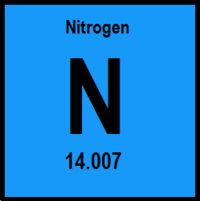Atomic number of nitrogen Last appearing in the LA Times puzzle on May 30, 19 this clue has a 5 letters answer. Below you will find the answer to the clue but if it doesn't fit please feel free to contact us directly or write a comment to discuss it. Nitrogen is a chemical element with symbol N and atomic number 7. It was first discovered and isolated by Scottish physician Daniel Rutherford in 1772. History and Discovery. Nitrogen is one of the prehsitric elements. And its use as ammonium chdirde has been known to Herodotus, Middle Ages civilizations and Alchemists. The atomic number of isotope nitrogen-15 is Even though Nitrogen 15 is an isotope ('normal' N is Nitrogen 14) the atomic number doesn't change and it is 7, because all Nitrogen has 7 protons! Isotopes are heavier (with more neutrons) or lighter (with less neutrons) versions of an element. Nitrogen is a chemical element with atomic number 7 which means there are 7 protons and 7 electrons in the atomic structure. The chemical symbol for Nitrogen is N. Atomic Mass of Nitrogen Atomic mass of Nitrogen is 14.0067 u.
- What Is Atomic Number For Nitrogen
- Atomic Number Nitrogen Monoxide
- Atomic Number For Nitrogen
- Atomic Number For Nitrogen 15
- Nitrogen Chemical Series

| In chemistry laboratories, liquid nitrogen is often stored in large thermos-like containers called 'dewars.' It boils at minus 195.8°C (-321 F) and is used for cooling. |
Nitrogen

| Atomic Number: | 7 | Atomic Radius: | 155 pm (Van der Waals) |
| Atomic Symbol: | N | Melting Point: | -210.0 °C |
| Atomic Weight: | 14.01 | Boiling Point: | -195.795 °C |
| Eectron Configuration: | [He]2s22p3 | Oxidation States: | 5, 4, 3, 2, 1, −1, −2, −3 (a strongly acidic oxide) |

What Is Atomic Number For Nitrogen
History
From the Latin word nitrum, Greek Nitron, native soda; and genes, forming. Nitrogen was discovered by chemist and physician Daniel Rutherford in 1772. He removed oxygen and carbon dioxide from air and showed that the residual gas would not support combustion or living organisms. At the same time there were other noted scientists working on the problem of nitrogen. These included Scheele, Cavendish, Priestley, and others. They called it 'burnt' or' dephlogisticated air,' which meant air without oxygen.
Sources
Nitrogen gas (N2) makes up 78.1% of the Earth’s air, by volume. The atmosphere of Mars, by comparison, is only 2.6% nitrogen. From an exhaustible source in our atmosphere, nitrogen gas can be obtained by liquefaction and fractional distillation. Nitrogen is found in all living systems as part of the makeup of biological compounds.
Atomic Number Nitrogen Monoxide
The Element
The French chemist Antoine Laurent Lavoisier mistakenly named nitrogen azote, meaning without life. However, nitrogen compounds are found in foods, organic materials, fertilizers, poisons, and explosives. Nitrogen, as a gas is colorless, odorless, and generally considered an inert element. As a liquid (boiling point = minus 195.8°C), it is also colorless and odorless, and is similar in appearance to water. Nitrogen gas can be prepared by heating a water solution of ammonium nitrite (NH4NO3).
Nitrogen Compounds and Nitrogen in Nature
Sodium nitrate (NaNO3) and potassium nitrate (KNO3) are formed by the decomposition of organic matter with compounds of these metals present. In certain dry areas of the world these saltpeters are found in quantity and are used as fertilizers. Other inorganic nitrogen compounds are nitric acid (HNO3), ammonia (NH3), the oxides (NO, NO2, N2O4, N2O), cyanides (CN-), etc.
The nitrogen cycle is one of the most important processes in nature for living organisms. Although nitrogen gas is relatively inert, bacteria in the soil are capable of “fixing” the nitrogen into a usable form (as a fertilizer) for plants. In other words, Nature has provided a method to produce nitrogen for plants to grow. Animals eat the plant material where the nitrogen has been incorporated into their system, primarily as protein. The cycle is completed when other bacteria convert the waste nitrogen compounds back to nitrogen gas. Nitrogen is crucial to life, as it is a component of all proteins.
Atomic Number For Nitrogen

Atomic Number For Nitrogen 15
Ammonia
Nitrogen Chemical Series
Ammonia (NH3) is the most important commercial compound of nitrogen. It is produced by the Haber Process. Natural gas (methane, CH4) is reacted with steam to produce carbon dioxide and hydrogen gas (H2) in a two step process. Hydrogen gas and nitrogen gas reacted via the Haber Process to produce ammonia. This colorless gas with a pungent odor is easily liquefied (in fact, the liquid is used as a nitrogen fertilizer). Ammonia is also used in the production of urea, NH2CONH2, which is used as a fertilizer, used in the plastic industry, and used in the livestock industry as a feed supplement. Ammonia is often the starting compound for many other nitrogen compounds.
